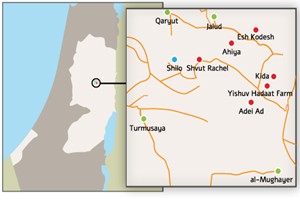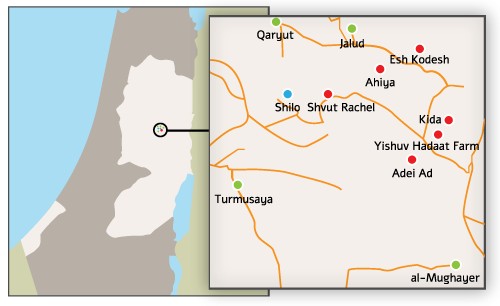
Some 100 outposts – illegal Jewish settlement points in the West Bank – have been built to date. In a new Yesh Din report, the settlement of Adei Ad serves as a test case illustrating how the foundation and establishment of an outpost leads the farmers in the nearby villages to lose their ability to work their land. The observation of a single outpost helps understand the general phenomenon and the method of the outposts as a means to take over Palestinian land.
The outpost of Adei Ad was founded in the fall of 1998. Over the years that have followed, Israeli civilians have committed and continue to commit dozens of criminal and administrative offenses on and around the outpost. The agencies responsible for law enforcement in the occupied West Bank fail to perform this function adequately. This enforcement failure is shared by the occupation Israeli army (IDF), which is responsible via the Civil Administration for enforcement against the administrative offenses that include illegal construction and invasions of agricultural land; and the Samaria & Judea (SJ) District Police, which is responsible for enforcement against criminal offenses including violence, property offenses and the takeover of land, and is obligated to prevent crimes, locate offenders and complete investigations so that they lead to serving indictments against suspects.

Map of settlements and Arab-Palestinian villages near Adei Ad in occupied West Bank (Yesh Din)
The founding of Adei Ad led the IDF to define extensive areas as no entry zones for Palestinians, and to allow Palestinians into other agricultural areas only with IDF permission and advance coordination. Other areas have become inaccessible to Palestinians following events of violence, harassment and threats by Israeli civilians who have intimidated the Palestinian farmers. Consequently many farmers are unable to cultivate their land or can do so only partially and discontinuously.
According to Yesh Din “this report presents the connection between the failure of the authorities responsible for law enforcement and the protection of Palestinians and their property, and the dispossession of Palestinians from their land, by drawing a continuum that begins with the absence of effective law enforcement upon Israeli civilians, both on the criminal and the administrative levels, and ends with the inability of the Palestinian land owners to work their land and live off its fruit.”
Related:
The full report
Press here for the interactive website – The Road to Dispossession


